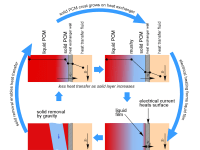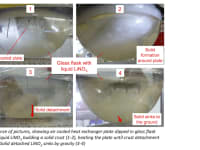Solids are better insulators than liquids and there are materials that are more dense in their solid rather than their liquid phase. These two facts are at the heart of an innovative way to improve efficiency in concentrated solar energy plants. Formation of crusts of solid phase change materials reduces efficiency during operation. Addition of an electrically heated surface on the heat exchanger, intermittently operated, allows gravity to remove solid crusts, increasing operational efficiency.
Concentrated Solar Plants (CSP) produce electricity from the sun’s energy. Solar energy is transferred via collectors and receiver(s) to a power cycle where a working fluid, typically water, is evaporated under pressure and then expanded in a turbine to drive a generator. CSP plants can store energy as heat, allowing operation at night, an advantage over photovoltaic cells that operate only during the day. An efficient heat storage system (at temperatures up to 565°C) improves the operating economics of CSP electricity generation by allowing electricity production to load follow regardless of time of day.
Phase change storage stores more heat in less material, making it an attractive option for CSP. Phase change materials (PCM) undergo melting and so store heat in the molten material. One limitation is the low thermal conductivity of economically valuable PCMs such as alkaline nitrates that is most severe in the solid phase. Solid formation inhibits rapid heat transfer from the PCM through a heat exchanger to the working fluid. The heat duty significantly reduces with time and is soon too low for being able to run turbines for electricity generation. Solid fouling of the heat exchanger, and the reduction in the heat transfer rate, must be prevented to keep a constant energy rate. As soon as the PCM has given up its heat and solidified, a solid “crust” forms that inhibits any further rapid heat transfer from the hot storage liquid to the working fluid.
The proposed design (Prov US62469644) identifies a working combination of PCM (LiNO3 - a salt) and a means of detaching the solid crust that limits the heat transfer. Laboratory tests show detachment of solid LiNO3 by gravity after short electrical resistance heating of the interface between the crust and the steel of the heat exchanger. After detachment, the heat exchange area can be reused for crystallizing further solids during the heat transfer from the liquid salt. Repeating cycles of heat extraction and electrical detachment, ensure an almost constant heat duty delivery until all the source heat from the liquid LiNO3 is exhausted. The design promises to reduce the capital cost (in the form of high-grade steel), since the efficient reuse of heat exchanger area brings the cost of the heat exchanger to a reasonable level that enables the PCM storage to be economically attractive for CSP; currently the capital cost associated with storing and reusing solar energy acts as an impediment to the widespread commercial introduction of such storage systems. The design is thus an enabler for the commercial viability of harnessing abundant solar energy.
Like this entry?
-
About the Entrant
- Name:Christoph Lang
- Type of entry:teamTeam members:Christoph Lang, Dow Chemical, R&D Heat management & Lubricants Colmar Wocke, Dow Chemical, Core R&D Mark Jones, Dow Chemical, Executive Strategy and Communications Fellow
- Software used for this entry:MS Excel
- Patent status:patented








